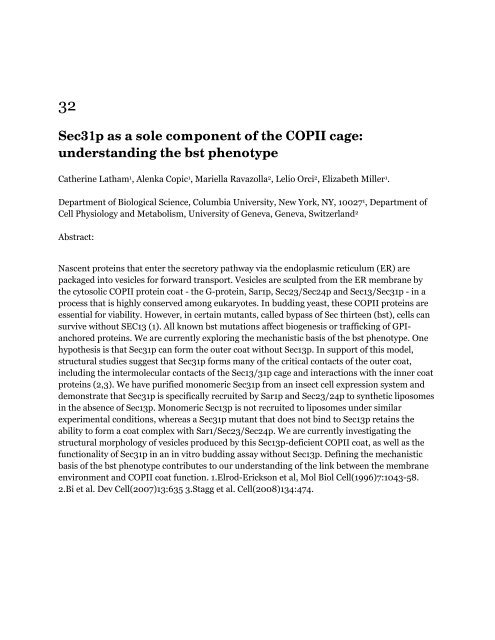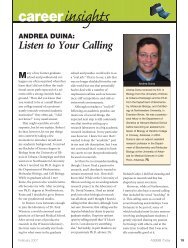View Program - asbmb
View Program - asbmb
View Program - asbmb
- TAGS
- program
- asbmb
- www.asbmb.org
Create successful ePaper yourself
Turn your PDF publications into a flip-book with our unique Google optimized e-Paper software.
32<br />
Sec31p as a sole component of the COPII cage:<br />
understanding the bst phenotype<br />
Catherine Latham 1 , Alenka Copic 1 , Mariella Ravazolla 2 , Lelio Orci 2 , Elizabeth Miller 1 .<br />
Department of Biological Science, Columbia University, New York, NY, 10027 1 , Department of<br />
Cell Physiology and Metabolism, University of Geneva, Geneva, Switzerland 2<br />
Abstract:<br />
Nascent proteins that enter the secretory pathway via the endoplasmic reticulum (ER) are<br />
packaged into vesicles for forward transport. Vesicles are sculpted from the ER membrane by<br />
the cytosolic COPII protein coat - the G-protein, Sar1p, Sec23/Sec24p and Sec13/Sec31p - in a<br />
process that is highly conserved among eukaryotes. In budding yeast, these COPII proteins are<br />
essential for viability. However, in certain mutants, called bypass of Sec thirteen (bst), cells can<br />
survive without SEC13 (1). All known bst mutations affect biogenesis or trafficking of GPIanchored<br />
proteins. We are currently exploring the mechanistic basis of the bst phenotype. One<br />
hypothesis is that Sec31p can form the outer coat without Sec13p. In support of this model,<br />
structural studies suggest that Sec31p forms many of the critical contacts of the outer coat,<br />
including the intermolecular contacts of the Sec13/31p cage and interactions with the inner coat<br />
proteins (2,3). We have purified monomeric Sec31p from an insect cell expression system and<br />
demonstrate that Sec31p is specifically recruited by Sar1p and Sec23/24p to synthetic liposomes<br />
in the absence of Sec13p. Monomeric Sec13p is not recruited to liposomes under similar<br />
experimental conditions, whereas a Sec31p mutant that does not bind to Sec13p retains the<br />
ability to form a coat complex with Sar1/Sec23/Sec24p. We are currently investigating the<br />
structural morphology of vesicles produced by this Sec13p-deficient COPII coat, as well as the<br />
functionality of Sec31p in an in vitro budding assay without Sec13p. Defining the mechanistic<br />
basis of the bst phenotype contributes to our understanding of the link between the membrane<br />
environment and COPII coat function. 1.Elrod-Erickson et al, Mol Biol Cell(1996)7:1043-58.<br />
2.Bi et al. Dev Cell(2007)13:635 3.Stagg et al. Cell(2008)134:474.






